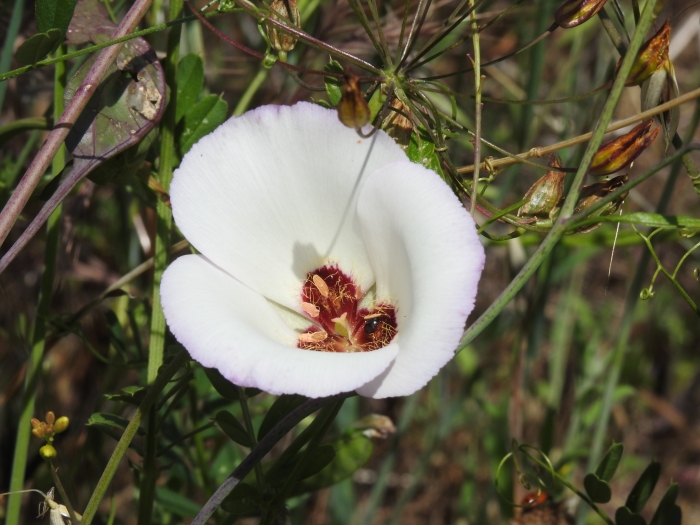Santa Catalina Mariposa Lily
(Calochortus catalinae)
Santa Catalina Mariposa Lily (Calochortus catalinae)
/
/

Andy Kleinhesselink
Public Domain
Image By:
Andy Kleinhesselink
Recorded By:
Copyright:
Public Domain
Copyright Notice:
Photo by: Andy Kleinhesselink | License Type: Public Domain | License URL: http://creativecommons.org/publicdomain/zero/1.0/ | Rights Holder: Andy Kleinhesselink | Publisher: iNaturalist | Date Created: 2019-05-25T11:18:39-07:00 |




















































Estimated Native Range
Summary
Calochortus catalinae, commonly known as Santa Catalina Mariposa Lily, is a deciduous perennial herb that is native to the grasslands and chaparral regions of Southern California, particularly on Santa Catalina Island. It typically grows up to 60 centimeters in height and produces long basal leaves and tall, branching stems. The flowers are particularly striking, with purple-tinted sepals up to 3 centimeters long and petals that are usually white or very pale pink, each with a distinctive blotch of purple or deep red at the base. The bowl of the petals may feature sparse long hairs, and the anthers are usually light in color, often pink. The flowering season is in the spring to early summer, and the flowers are quite showy, attracting pollinators such as bees and butterflies.
Santa Catalina Mariposa Lily is valued for its ornamental flowers and is used in wildflower gardens, native plant landscapes, and as a border plant. It is relatively easy to maintain, provided it is grown under the right conditions. It requires part shade, medium amounts of water, and well-drained soils. While it is drought-tolerant once established, it does not tolerate overwatering or poorly drained soils. There are no major disease issues, but it can be susceptible to root rot if overwatered. It is not known to be invasive when grown outside its native range, but as with all native plants, care should be taken to prevent escape into natural areas.CC BY-SA 4.0
Santa Catalina Mariposa Lily is valued for its ornamental flowers and is used in wildflower gardens, native plant landscapes, and as a border plant. It is relatively easy to maintain, provided it is grown under the right conditions. It requires part shade, medium amounts of water, and well-drained soils. While it is drought-tolerant once established, it does not tolerate overwatering or poorly drained soils. There are no major disease issues, but it can be susceptible to root rot if overwatered. It is not known to be invasive when grown outside its native range, but as with all native plants, care should be taken to prevent escape into natural areas.CC BY-SA 4.0
Plant Description
- Plant Type: Herb
- Height: 1-2 feet
- Width: 0.2-0.5 feet
- Growth Rate: Moderate
- Flower Color: Purple, White
- Flowering Season: Spring
- Leaf Retention: Deciduous
Growth Requirements
- Sun: Part Shade
- Water: Medium
- Drainage: Medium
Common Uses
Low Maintenance, Potted Plant, Rock Garden, Showy Flowers
Natural Habitat
Native to the grasslands and chaparral regions of Southern California, particularly on Santa Catalina Island
Other Names
Common Names: Catalina Mariposa-Lily
Scientific Names: , Calochortus catalinae, Calochortus lyonii, Mariposa catalinae,
GBIF Accepted Name: Calochortus catalinae S.Watson